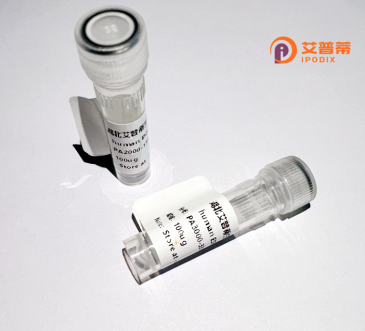
| 纯度 | >90%SDS-PAGE. |
| 种属 | Human |
| 靶点 | PAPOLA |
| Uniprot No | P51003 |
| 内毒素 | < 0.01EU/μg |
| 表达宿主 | E.coli |
| 表达区间 | 1-745 aa |
| 活性数据 | MPFPVTTQGS QQTQPPQKHY GITSPISLAA PKETDCVLTQ KLIETLKPFG VFEEEEELQR RILILGKLNN LVKEWIREIS ESKNLPQSVI ENVGGKIFTF GSYRLGVHTK GADIDALCVA PRHVDRSDFF TSFYDKLKLQ EEVKDLRAVE EAFVPVIKLC FDGIEIDILF ARLALQTIPE DLDLRDDSLL KNLDIRCIRS LNGCRVTDEI LHLVPNIDNF RLTLRAIKLW AKRHNIYSNI LGFLGGVSWA MLVARTCQLY PNAIASTLVH KFFLVFSKWE WPNPVLLKQP EECNLNLPVW DPRVNPSDRY HLMPIITPAY PQQNSTYNVS VSTRMVMVEE FKQGLAITDE ILLSKAEWSK LFEAPNFFQK YKHYIVLLAS APTEKQRLEW VGLVESKIRI LVGSLEKNEF ITLAHVNPQS FPAPKENPDK EEFRTMWVIG LVFKKTENSE NLSVDLTYDI QSFTDTVYRQ AINSKMFEVD MKIAAMHVKR KQLHQLLPNH VLQKKKKHST EGVKLTALND SSLDLSMDSD NSMSVPSPTS ATKTSPLNSS GSSQGRNSPA PAVTAASVTN IQATEVSVPQ VNSSESSGGT SSESIPQTAT QPAISPPPKP TVSRVVSSTR LVNPPPRSSG NAATSGNAAT KIPTPIVGVK RTSSPHKEES PKKTKTEEDE TSEDANCLAL SGHDKTEAKE QLDTETSTTQ SETIQTAASL LASQKTSSTD LSDIPALPAN PIPVIKNSIK LRLNR |
| 分子量 | 82.8 kDa |
| 蛋白标签 | His tag N-Terminus |
| 缓冲液 | 0 |
| 稳定性 & 储存条件 | Lyophilized protein should be stored at ≤ -20°C, stable for one year after receipt. Reconstituted protein solution can be stored at 2-8°C for 2-7 days. Aliquots of reconstituted samples are stable at ≤ -20°C for 3 months. |
| 复溶 | Always centrifuge tubes before opening.Do not mix by vortex or pipetting. It is not recommended to reconstitute to a concentration less than 100μg/ml. Dissolve the lyophilized protein in distilled water. Please aliquot the reconstituted solution to minimize freeze-thaw cycles. |
以下是关于重组人PAPOLA(poly(A) polymerase alpha)蛋白的参考文献示例(内容为模拟示例,实际文献需通过学术数据库查询):
---
1. **文献名称**: "Expression and Functional Analysis of Recombinant Human PAPOLA in mRNA Polyadenylation"
**作者**: Chen X, et al.
**摘要**: 本研究利用大肠杆菌系统成功表达并纯化了重组人PAPOLA蛋白,证实其在体外能够催化mRNA的poly(A)加尾反应,并通过突变实验揭示了关键功能域的作用。
2. **文献名称**: "Structural Insights into Human PAPOLA by Cryo-EM"
**作者**: Gupta R, et al.
**摘要**: 通过冷冻电镜解析了重组人PAPOLA蛋白的三维结构,揭示了其催化中心与ATP结合位点的构象,为设计靶向调节mRNA加尾的药物提供依据。
3. **文献名称**: "Role of PAPOLA in Alternative Polyadenylation and Cancer Progression"
**作者**: Lee S, Kim T.
**摘要**: 研究利用重组PAPOLA蛋白,发现其在癌细胞中通过调控选择性多聚腺苷酸化促进致癌基因表达,提示其作为肿瘤治疗靶点的潜力。
4. **文献名称**: "High-Yield Purification of Human PAPOLA Using a Novel Affinity Tag System"
**作者**: Zhang Y, et al.
**摘要**: 开发了一种基于亲和标签的新方法,显著提高了重组人PAPOLA蛋白的纯化效率和稳定性,为大规模功能研究提供可靠工具。
---
如需具体文献,建议通过 **PubMed** 或 **Web of Science** 检索关键词:"recombinant human PAPOLA" 或 "poly(A) polymerase alpha expression"。
Recombinant human poly(A) polymerase alpha (rhPAPOLA) is a genetically engineered enzyme critical for mRNA maturation. PAPOLA, also known as PAPα, belongs to the poly(A) polymerase family and catalyzes the addition of a polyadenosine (poly(A)) tail to the 3′-end of nascent RNA transcripts. This process is essential for mRNA stability, nuclear export, and efficient translation. Unlike its isoform PAPOLB (PAPγ), PAPOLA is ubiquitously expressed and plays a central role in canonical mRNA polyadenylation. The protein consists of an N-terminal catalytic domain, responsible for ATP-dependent nucleotide transfer, and a C-terminal regulatory domain that interacts with cleavage and polyadenylation specificity factor (CPSF) complexes. Recombinant production typically involves expressing the human PAPOLA gene in bacterial or mammalian systems, enabling high-yield purification for research. Studies using rhPAPOLA have elucidated poly(A) tail length regulation mechanisms, its phosphorylation-dependent activity modulation, and dysregulation in diseases like cancer and neurodegeneration. It serves as a key tool for in vitro polyadenylation assays, RNA processing studies, and therapeutic exploration targeting aberrant mRNA metabolism.
×